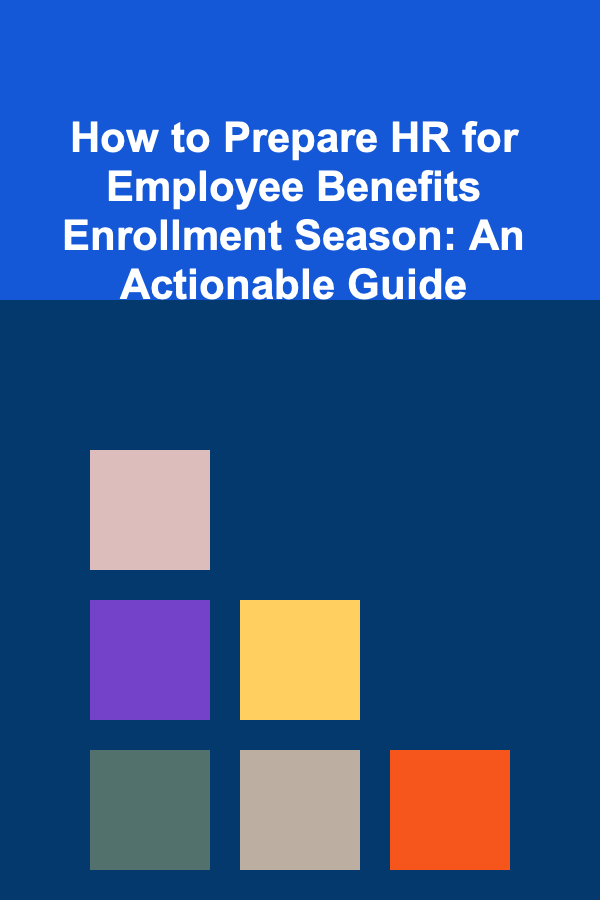
How to Prepare HR for Employee Benefits Enrollment Season: An Actionable Guide
ebook include PDF & Audio bundle (Micro Guide)
$12.99$8.99
Limited Time Offer! Order within the next:

Employee benefits enrollment is a crucial period for both employees and the HR department. It's when employees make decisions about their health, wellness, and financial benefits for the upcoming year. For HR teams, this period can be challenging due to the volume of inquiries, the complexity of plan options, and the tight timeline to ensure everything is processed correctly.
Preparing HR for benefits enrollment season requires proactive planning, effective communication, and careful attention to detail. This guide will walk you through the necessary steps to ensure HR is fully prepared to handle the upcoming benefits enrollment season efficiently and smoothly.
Plan Ahead: Establish a Timeline and Checklist
The first step in preparing HR for benefits enrollment season is creating a detailed timeline. The enrollment season is often a hectic period, so ensuring that every aspect of the process is planned and well-coordinated will alleviate stress for the HR team and employees alike.
Actionable Steps:
-
Create a Benefits Enrollment Calendar: Start by marking key dates, including the start and end of the enrollment period, deadlines for employees to submit their benefits selections, and dates when benefits providers need information.
- Example: Enrollment period starts on November 1st and ends on November 30th.
-
Establish Internal Milestones: Create internal milestones to track HR's progress. For instance, HR might aim to finalize benefits plan options and provider contracts by October 15th, ensuring that the benefits portal is ready by October 30th.
-
Checklist of Tasks: Break down the major tasks HR needs to accomplish, such as communicating benefits options to employees, preparing educational materials, reviewing data from last year's enrollment, and training HR staff to answer questions.
Review and Update Benefits Offerings
Before benefits enrollment begins, HR needs to review and possibly update the benefits offerings for the upcoming year. This involves collaborating with leadership, benefits providers, and insurance brokers to assess which plans and benefits will be available to employees.
Actionable Steps:
- Evaluate Current Benefits Packages: Assess whether the current benefits packages are meeting employees' needs. Collect feedback from employees about their experiences with the benefits they selected in the previous year. Consider areas for improvement, such as offering new wellness programs or updating healthcare plans to reflect current trends.
- Ensure Compliance with Regulatory Changes: Stay informed about any legal or regulatory changes affecting employee benefits, such as adjustments to healthcare plans, tax laws, or compliance with the Affordable Care Act (ACA). These changes must be reflected in the benefits offerings.
- Consult with Benefits Providers: Work closely with insurance providers, wellness program administrators, and financial planners to ensure that the benefit offerings for the next enrollment season are both competitive and compliant. Negotiate plan options, premiums, and coverage to offer employees the best possible selection.
- Introduce New Benefits: If applicable, introduce new benefits such as mental health support, telemedicine services, or flexible spending accounts (FSAs). Ensure that these offerings are well communicated and understood by employees.
Prepare Communication Materials for Employees
Effective communication is key to a smooth benefits enrollment process. HR should be prepared to answer employees' questions, provide clear instructions, and explain the available options. Employees often need time to review, compare, and select benefits that best suit their needs, so it's crucial to provide the right materials in a timely manner.
Actionable Steps:
- Create a Benefits Guide: Develop a comprehensive benefits guide or brochure that clearly explains the benefits available, eligibility requirements, plan details, and any important deadlines. This guide should be easy to understand, visually appealing, and available in both digital and print formats.
- Prepare FAQs: Anticipate common questions employees might have about the benefits offerings. Create a well-organized Frequently Asked Questions (FAQ) document to address topics such as how to change benefits, which plan is right for them, and what to do if they miss the deadline.
- Utilize Multiple Channels for Communication: Reach employees through various channels, such as email newsletters, intranet posts, webinars, or virtual town halls. Make sure the communication is clear and provides employees with easy access to the information they need.
- Provide Support Resources: Consider setting up a benefits hotline, a dedicated email inbox, or virtual office hours during enrollment. This gives employees the opportunity to ask specific questions they may have about their options.
Offer Benefits Education and Support
One of the most important aspects of preparing for benefits enrollment is ensuring that employees are educated about the options available to them. Without proper guidance, employees may make choices that don't align with their needs, which could lead to dissatisfaction later on.
Actionable Steps:
- Host Benefits Information Sessions: Organize webinars, workshops, or one-on-one meetings with employees to explain the benefits options available and help them understand the details of each plan. Invite benefits providers, brokers, or consultants to provide expert advice and answer employee questions.
- Offer Interactive Tools: Provide employees with online tools such as benefits calculators or comparison charts that allow them to compare different plans side by side. This empowers employees to make more informed decisions.
- Tailor Education to Specific Groups: Recognize that different employee groups may have different needs. For example, young employees may be more interested in health savings accounts (HSAs) or student loan assistance, while employees with families may need more comprehensive healthcare coverage. Tailor the educational materials to meet the diverse needs of your workforce.
Leverage Technology for a Streamlined Process
Using technology to manage the benefits enrollment process can save time, reduce errors, and improve the overall experience for employees and HR teams. Investing in HR software or a dedicated benefits platform can help automate administrative tasks, track employee selections, and ensure compliance.
Actionable Steps:
- Choose the Right Benefits Enrollment Platform: Consider adopting a digital benefits enrollment system that allows employees to review, select, and enroll in benefits online. Many platforms integrate with payroll and HR systems to automate data processing, ensuring accuracy.
- Ensure Data Security: Benefits enrollment involves sensitive employee information. Make sure that the platform you choose is secure and complies with data protection regulations such as GDPR or HIPAA.
- Enable Employee Self-Service: Provide employees with the ability to view their benefits information, make changes, and track their enrollment status. A self-service portal reduces the administrative burden on HR and provides employees with a seamless experience.
- Integrate with Other HR Systems: Ensure that the benefits platform integrates with your payroll, time management, and employee management systems. This creates a more streamlined process, minimizes data entry errors, and improves efficiency.
Prepare HR Staff for Inquiries and Support
HR staff will likely be fielding many questions from employees during the enrollment period. It's essential to prepare them to handle inquiries efficiently and effectively, so they can provide employees with the support they need.
Actionable Steps:
- Provide Training: Hold training sessions for HR staff to familiarize them with the benefits offerings, the enrollment process, and how to use the benefits enrollment system. Make sure they are well-equipped to answer employee questions and troubleshoot any issues that arise.
- Create Knowledge Resources: Develop internal resources such as quick reference guides or cheat sheets that HR staff can use to find answers to common questions quickly. This will help HR staff manage the volume of inquiries without delays.
- Encourage Empathy and Patience: During benefits enrollment, employees may feel overwhelmed by the decisions they need to make. Encourage HR staff to be empathetic, patient, and supportive when assisting employees through the process.
Monitor and Review the Process
Once the benefits enrollment season is underway, it's essential to monitor the progress of the process, address any issues, and ensure that the enrollment is proceeding as planned.
Actionable Steps:
- Track Enrollment Progress: Regularly monitor how many employees have enrolled, made changes to their benefits, or completed their selections. This allows you to identify any bottlenecks or areas where employees may need additional support.
- Collect Feedback: After the enrollment period ends, gather feedback from employees about their experience. Use surveys or informal check-ins to understand what went well and what could be improved in the future.
- Ensure Timely Processing: Once the enrollment period ends, make sure that all benefits elections are processed in a timely manner. Verify that the correct information is sent to benefits providers, and address any discrepancies immediately.
Conclusion
Preparing HR for benefits enrollment season is a multifaceted process that requires careful planning, clear communication, and effective use of technology. By taking the time to review benefits offerings, educate employees, streamline administrative tasks, and provide HR staff with the necessary tools and resources, organizations can ensure a smooth and successful benefits enrollment season.
By staying proactive and organized, HR teams can handle this important task with confidence, helping employees make the best choices for their health and well-being while ensuring compliance and efficiency for the company.

How to Create a Sustainable Workspace with Minimal Waste
Read More
How to Design a Functional Workspace for Your Hobby
Read More
How to Leverage Technology for Smart Investing
Read More
How to Trade Cryptocurrencies on Blockchain Exchanges
Read More
How to Use Clear Bins for Easy Fitness Equipment Storage
Read More
The Best Affordable Meal Prep and Planning Resources for Healthy Eating
Read MoreOther Products

How to Create a Sustainable Workspace with Minimal Waste
Read More
How to Design a Functional Workspace for Your Hobby
Read More
How to Leverage Technology for Smart Investing
Read More
How to Trade Cryptocurrencies on Blockchain Exchanges
Read More
How to Use Clear Bins for Easy Fitness Equipment Storage
Read More